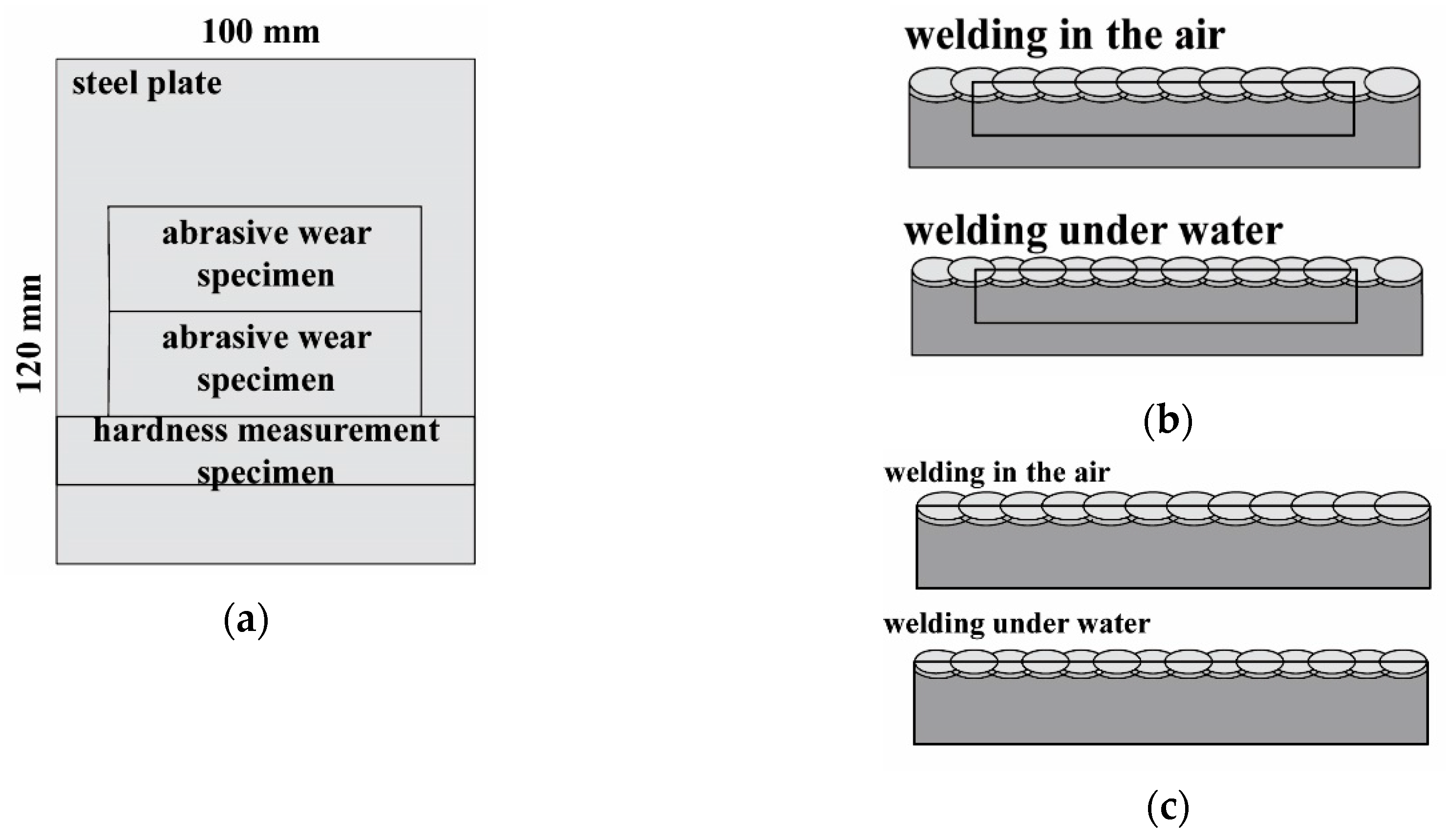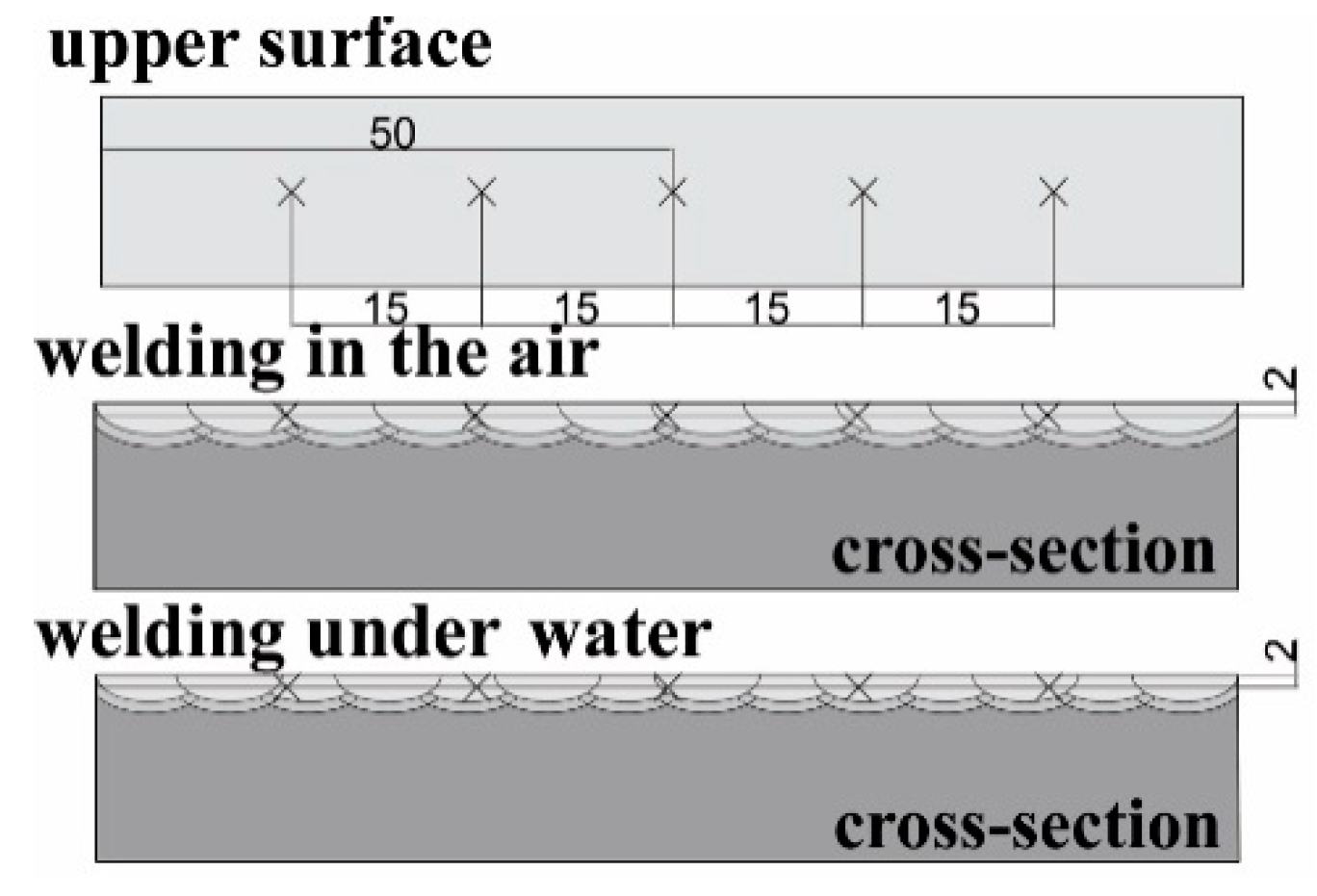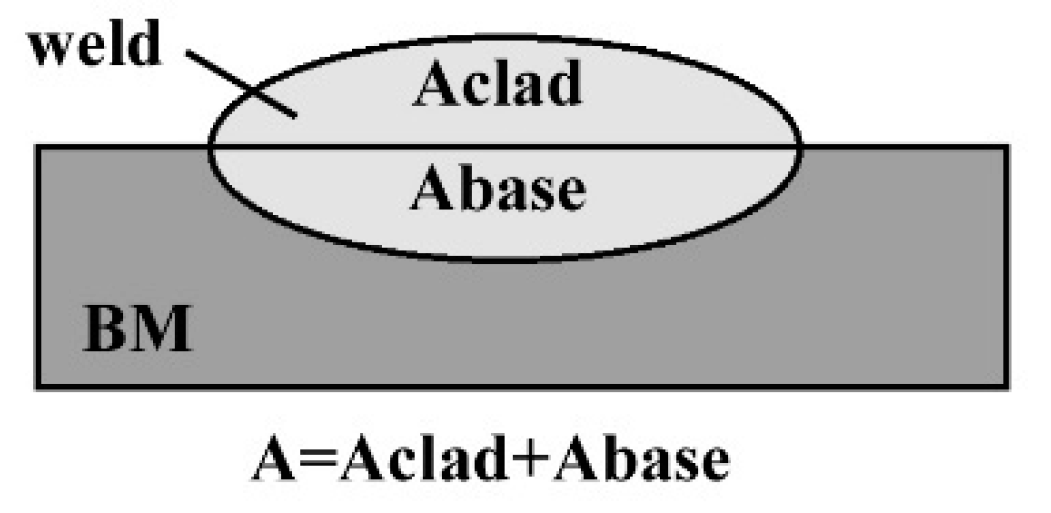The Abrasive Wear Resistance of Coatings Manufactured on High-Strength Low-Alloy (HSLA) Offshore Steel in Wet Welding Conditions
Abstract
:1. Introduction
2. Materials and Methods
2.1. Used Materials
2.2. Welding Procedure
2.3. Examination Procedure
3. Results and Discussions
3.1. Abrasive Wear Resistance
3.2. Hardness HV10 Measurements
3.3. Microscopic Study
4. Conclusions
- Water, as an environment of the welding processes, generates higher HV10 hardness of steel coatings than air does. The microstructure of coatings performed in the water contains the brittle structures in the HAZ, which resulted from a high cooling rate. The structures for specimens manufactured in the air are characterized by the presence of normalized structures.
- The hardness strongly depends on the welding environment, but no influence on the abrasive wear resistancewas found, neither in the air nor in the water environment.
- The coatings produced by the electrodes for underwater welding (Barracuda Gold) are characterized by a lower volume loss in the metal–mineral abrasion conditions than layers welded by the general usage electrodes (Omnia). This is due to the smaller grain size of the weld metal produced in the air (Barracuda Gold), and the greater number of cracks for coating made in the water (Omnia).
- The water environment of welding produces coatings with higher abrasive wear resistance than layers welded in the air, which resulted from different metallographic microstructures formed in coatings manufactured in other environments.
Author Contributions
Funding
Acknowledgments
Conflicts of Interest
References
- Dehghani, A.; Aslani, F. A review on defects in steel offshore structures and developed strengthening techniques. Structures 2019, 20, 635–657. [Google Scholar] [CrossRef]
- Price, S.J.; Figueira, R.B. Corrosion protection systems and fatigue corrosion in offshore wind structures: Current status and future perspectives. Coatings 2017, 7, 25. [Google Scholar] [CrossRef]
- Papatheocharis, T.; Saravanis, G.C.; Perdikaris, P.C.; Karamanos, S.A. Fatigue of welded tubular X-joints in offshore wind platforms. In International Conference on Offshore Mechanics and Arctic Engineering, Proceedings of the ASME 2019 38th International Conference on Ocean, Offshore and Arctic Engineering, Glasgow, Scotland, UK, 9–14 June 2019; Materials Technology; ASME: New York, NY, USA, 2019; Volume 4. [Google Scholar] [CrossRef]
- Kong, X.; Lv, J.; Gao, N.; Peng, X.; Zhang, J. An experimental study of galvanic corrosion on an underwater weld joint. J. Coast. Res. 2018, 84, 63–68. [Google Scholar] [CrossRef]
- Liang, L.; Pang, Y.; Zhu, Z.; Tang, Y.; Xiang, Y. Influencing factors of various combinations of abrasion, cavitation and corrosion caused by multiphase flow impact. Trans. Can. Soc. Mech. Eng. 2019, 43, 130. [Google Scholar] [CrossRef]
- Momber, A.W.; Marquardt, T. Protective coatings for offshore wind energy devices (OWEAs): A review. J. Coat. Technol. Res. 2018, 15, 13–40. [Google Scholar] [CrossRef]
- López-Ortega, A.; Arana, J.L.; Rodriguez, E.; Bayón, R. Corrosion, wear and tribocorrosion performance of a thermally sprayed aluminum coating modified by plasma electrolytic oxidation technique for offshore submerged components protection. Corros. Sci. 2018, 143, 258–280. [Google Scholar] [CrossRef]
- Łatka, L.; Szala, M.; Michalak, M.; Pałka, T. Impact of atmospheric plasma spray parameters on cavitation erosion resistance of Al2O3-13% TiO2 coatings. Acta Phys. Pol. A 2019, 136, 342–347. [Google Scholar] [CrossRef]
- He, X.; Song, R.G.; Kong, D.J. Microstructure and corrosion behaviours of composite coatings on S355 offshore steel prepared by laser cladding combined with micro-arc oxidation. Appl. Surf. Sci. 2019, 497, 143703. [Google Scholar] [CrossRef]
- Li, Y.; Li, C.; Tang, S.; Zheng, Q.; Wang, J.; Zhang, Z.; Wang, Z. Interfacial bonding and abrasive wear behavior of iron matrix composite reinforced by ceramic particles. Materials 2019, 12, 3646. [Google Scholar] [CrossRef] [Green Version]
- Czupryński, A. Properties of Al2O3/TiO2and ZrO2/CaO flame-sprayed coatings. Mater. Tehnol./Mater. Technol. 2017, 51, 205–212. [Google Scholar] [CrossRef]
- Szala, M.; Dudek, A.; Maruszczyk, A.; Walczak, M.; Chmiel, J.; Kowal, M. Effect of atmospheric plasma sprayed TiO2—10% NiAl cermet coating thickness on cavitation erosion, sliding and abrasive wear resistance. Acta Phys. Pol. A 2019, 136, 335–341. [Google Scholar] [CrossRef]
- Czupryński, A.; Górka, J.; Adamiak, M.; Tomiczek, B. Testing of flame sprayed Al2O3matrix coatings containing TiO2. Arch. Metall. Mater. 2016, 61, 1363–1370. [Google Scholar] [CrossRef]
- Adamiak, M.; Czupryński, A.; Kopyść, A.; Monica, Z.; Olender, M.; Gwiazda, A. The Properties of Arc-Sprayed Aluminum Coatings on Armor-Grade Steel. Metals 2018, 8, 142. [Google Scholar] [CrossRef] [Green Version]
- Chmielewski, T.; Siwek, P.; Chmielewski, M.; Piątkowska, A.; Grabias, A.; Golański, D. Structure and selected properties of arc sprayed coatings containing in-situ fabricated Fe-Al intermetallic phases. Metals 2018, 8, 1059. [Google Scholar] [CrossRef] [Green Version]
- Czupryński, A. Flame spraying of aluminum coatings reinforced with particles of carbonaceous materials as an alternative for laser cladding technologies. Materials 2019, 12, 3467. [Google Scholar] [CrossRef] [Green Version]
- Górka, J.; Czupryński, A.; Żuk, M.; Adamiak, M.; Kopyść, A. Properties and structure of deposited nanocrystalline coatings in relation to selected construction materials resistant to abrasive wear. Materials 2018, 11, 1–15. [Google Scholar] [CrossRef] [Green Version]
- Chmielewski, T.; Hudycz, M.; Krajewski, A.; Sałaciński, T.; Skowrońska, B.; Świercz, R. Structure investigation on titanium metallization coating deposited onto AlN ceramics substrate by means of friction surfacing proces. Coatings 2019, 9, 845. [Google Scholar] [CrossRef] [Green Version]
- Liu, Y.; Li, C.X.; Huang, X.F.; Ma, K.; Luo, X.T.; Li, C.J. Effect of water environment on particle deposition of underwater cold spray. Appl. Surf. Sci. 2020, 506, 144542. [Google Scholar] [CrossRef]
- Feng, X.; Cui, X.; Zheng, W.; Lu, B.; Dong, M.; Wen, X.; Zhao, Y.; Jin, G. Effect of the protective materials and water on the repairing quality of nickel aluminum bronze during underwater wet laser repairing. Opt. Laser Technol. 2019, 114, 140–145. [Google Scholar] [CrossRef]
- Wen, X.; Jin, G.; Cui, X.; Feng, X.; Lu, B.; Cai, Z.; Zhao, Y.; Fang, Y. Underwater wet laser cladding on 316L stainless steel: A protective material assisted method. Opt. Laser Technol. 2019, 111, 814–824. [Google Scholar] [CrossRef]
- Fu, Y.; Guo, N.; Zhou, L.; Cheng, Q.; Feng, J. Underwater wire-feed laser deposition of the Ti–6Al–4V titanium alloy. Mater. Des. 2020, 186, 108284. [Google Scholar] [CrossRef]
- Cevik, B. The effect of pure argon and mixed gases on microstructural and mechanical properties of S275 structural steel joined by flux-cored arc welding. Kov. Mater. 2020, 56, 81–87. [Google Scholar] [CrossRef] [Green Version]
- Kik, T.; Moravec, J.; Nováková, I. Numerical simulations of X22CrMoV12-1 steel multilayer welding. Arch. Metall. Mater. 2019, 64, 1441–1448. [Google Scholar] [CrossRef]
- Srisuwan, N.; Kumsri, N.; Yingsamphancharoen, T.; Kaewvilai, A. Hardfacing welded ASTM A572-based, high-strength low-alloy steel: Welding, characterization, and surface properties related to the wear resistance. Metals 2019, 9, 244. [Google Scholar] [CrossRef] [Green Version]
- Triwanapong, S.; Angthong, A.; Kimapong, K. Interpass temperature affecting abrasive wear resistance of SMAW hard-faced weld metal on JIS-S50C carbon steel. Mater. Sci. Forum 2019, 950, 60–64. [Google Scholar] [CrossRef]
- Wang, J.; Sun, Q.; Teng, J.; Feng, J. Bubble evolution in ultrasonic wave-assisted underwater wet FCAW. Weld. J. 2019, 98, 150–163. [Google Scholar] [CrossRef]
- Guo, N.; Du, Y.; Maksimov, S.; Feng, J.; Yin, Z.; Krazhanovskyi, D.; Fu, Y. Study of metal transfer control in underwater wet FCAW using pulsed wire feed method. Weld. World 2018, 62, 87–94. [Google Scholar] [CrossRef]
- Yang, Q.; Han, Y.; Jia, C.; Wu, J.; Dong, S.; Wu, C. Impeding effect of bubbles on metal transfer in underwater wet FCAW. J. Manuf. Process. 2019, 45, 682–689. [Google Scholar] [CrossRef]
- Chen, H.; Guo, N.; Xu, K.; Xu, C.; Zhou, L.; Wang, G. In-situ observations of melt degassing and hydrogen removal enhanced by ultrasonics in underwater wet welding. Mater.Des. 2020, 108482. [Google Scholar] [CrossRef]
- Yan, C.; Kan, C.; Li, C.; Tian, S.; Bai, Y.; Xue, F. Experimental and numerical investigation on underwater wet welding of HSLA steel. IOP Conf. Ser. Mater. Sci. Eng. 2018, 394, 022016. [Google Scholar] [CrossRef]
- Tomków, J.; Fydrych, D.; Rogalski, G.; Łabanowski, J. Effect of the welding environment and storage time of electrodes on the diffusible hydrogen content in deposited metal. Rev. Metal. 2019, 55, e140. [Google Scholar] [CrossRef] [Green Version]
- Chen, H.; Gui, N.; Liu, C.; Zhang, X.; Xu, C.; Wang, G. Insight into hydrostatic pressure effects on diffusible hydrogen content in wet welding joints using in-situ X-ray imaging method. Int. J. Hyd. Energy 2020, in press. [Google Scholar] [CrossRef]
- Świerczyńska, A.; Fydrych, D.; Landowski, M.; Rogalski, G.; Łabanowski, J. Hydrogen embrittlement of X2CRNiMoCuN25-6-2- super duplex stainless steel welded joints under cathodic protection. Constr. Build. Mater. 2020, 238, 117697. [Google Scholar] [CrossRef]
- Tomków, J.; Fydrych, D.; Rogalski, G.; Łabanowski, J. Temper bead welding of S460N steel in wet welding conditions. Adv. Mater. Sci. 2018, 18, 5–14. [Google Scholar] [CrossRef] [Green Version]
- Gao, W.; Wang, D.; Cheng, F.; Di, X.; Den, C.; Xu, W. Microstructural and mechanical performance of underwater wet welded S355 steel. J. Mater. Process. Technol. 2016, 238, 333–340. [Google Scholar] [CrossRef]
- ISO 2560-A. Classification of Coated Rod Electrodes for Arc Welding of Unalloyed Steel and Fine-Grained Steel; ISO: Geneva, Switzerland, 2010. [Google Scholar]
- Tomków, J.; Fydrych, D.; Rogalski, G. Role of bead sequence in underwater welding. Materials 2019, 12, 3372. [Google Scholar] [CrossRef] [PubMed] [Green Version]
- ASTM G 65-00. Standard Test Method for Measuring Abrasion Using the Dry Sand/Rubber Wheel Apparatus; West Conshohocken, PA, USA, 2016. [Google Scholar]
- Szala, M.; Szafran, M.; Macek, W.; Marchenko, S.; Hejwowski, T. Abrasion resistance S235, C45, AISI 304 and Hardox 500 steels with usage of garnet, corundum and carborundum abrasives. Adv. Sci. Technol. Res. J. 2019, 13, 151–161. [Google Scholar] [CrossRef]
- EN ISO 9015-1:2011. Destructive Tests on Welds in Metallic Materials. Hardness Testing. Hardness Test on Arc Welded Joint; ISO: Geneva, Switzerland, 2011. [Google Scholar]
- EN ISO 17639:2013. Destructive Tests on Welds in Metallic Materials. Macroscopic and Microscopic Examination of Welds; ISO: Geneva, Switzerland, 2013. [Google Scholar]
- Chand, N.; Neogi, S. Mechanism of material removal during three-body abrasion of FRF composite. Tribol. Lett. 1998, 4, 81. [Google Scholar] [CrossRef]
- Singh, P.T.; Singla, A.K.; Singh, J.; Singh, K.; Gupta, M.K.; Ju, H.; Song, Q.; Liu, Z.; Pruncu, C.I. Abrasive wear behavion of cryogenically treated boron steel (30MnCrB4) used for rotavator blades. Materials 2020, 13, 436. [Google Scholar] [CrossRef] [Green Version]
- Jankauskas, V.; Kreivaitis, R.; Milcius, D.; Baltusnikas, A. Analysis of abrasive wear performance of arc welded hard layers. Wear 2008, 265, 1626–1632. [Google Scholar] [CrossRef] [Green Version]
- Sun, Y.L.; Obasi, G.; Hamelin, C.J.; Vasileiou, A.N.; Flint, T.F.; Balakrishnan, J.; Smith, M.C.; Francis, J.A. Effects of dilution on alloy content and microstructure in multi-pass steel welds. J. Mater. Process. Technol. 2019, 265, 71–86. [Google Scholar] [CrossRef]
- Saida, K.; Bunda, K.; Ogiwara, H.; Nishimoto, K. Microcracking susceptibility in dissimilar multipass welds of Ni-base alloy 690 and low-alloy steel. Weld. Int. 2015, 29, 668–680. [Google Scholar] [CrossRef]
- Coronado, J.J.; Caicedo, H.F.; Gómez, A.L. The effects of welding process on abrasive wear resistance for hardfacing deposits. Tribol. Int. 2009, 42, 745–749. [Google Scholar] [CrossRef]
- EN-ISO 15614-1:2017. Specification and Qualification of Welding Procedures for Metallic Materials—Welding Procedure Test—Part 1: Arc and Gas Welding of Steels and Arc Welding of Nickel and Nickel Alloys; ISO: Geneva, Switzerland, 2017. [Google Scholar]
- Guo, N.; Liu, D.; Guo, W.; Li, X.; Feng, J. Effect of Ni on microstructure and mechanical properties of underwater wet welding joint. Mater. Des. 2015, 77, 25–31. [Google Scholar] [CrossRef]
- Cui, Z.; Bhattacharya, S.; Green, D.E.; Alpas, A.T. Mechanisms of die wear and wear-induced damage at the trimmed edge of high strength steel sheets. Wear 2019, 426, 1635–1645. [Google Scholar] [CrossRef]











| Material | C | Si | Mn | P | Cr | Mo | Ni | Al | Cu | S | CeIIW ** |
|---|---|---|---|---|---|---|---|---|---|---|---|
| S355G10+N | 0.11 | 0.35 | 1.39 | 0.008 | 0.02 | 0.02 | 0.25 | 0.039 | 0.27 | - | 0.385 |
| Omnia E38 0 R 11 electrodes deposit * | 0.07 | 0.45 | 0.50 | 0.010 | - | - | - | - | 0.05 | - | - |
| Barracuda Gold E42 2 1Ni RR 51 deposit * | 0.05 | 0.45 | 0.55 | 0.025 | - | - | 0.30 | - | - | 0.025 | - |
| Specimen Designation | Number of Specimens | Weight before Test (g) | Weight after Test (g) | Mass Loss (g) | Density (g/cm3) | Volume Loss (mm3) | Average 1 Volume Loss (mm3) | Relative 2 Abrasion Resistance |
|---|---|---|---|---|---|---|---|---|
| O (OMNIA 46 electrode) | W1 | 156.6923 | 155.4087 | 1.2836 | 7.6927 | 166.8595 | 174.7537(11.1641) | 0.61 |
| W2 | 157.5938 | 156.1770 | 1.4168 | 7.7570 | 182.6479 | |||
| A1 | 152.3573 | 150.9207 | 1.4366 | 6.9626 | 206.3310 | 240.0881(47.7398) | 0.44 | |
| A2 | 158.2508 | 156.1954 | 2.0554 | 7.5057 | 273.8452 | |||
| B (Barracuda Gold electrode) | W1 | 152.0878 | 150.8147 | 1.2731 | 7.6565 | 166.2770 | 158.7265(10.6780) | 0.67 |
| W2 | 148.5804 | 147.4337 | 1.1467 | 7.5852 | 151.1760 | |||
| A1 | 151.3845 | 149.9140 | 1.4705 | 7.5319 | 195.2363 | 179.0374(22.9087) | 0.60 | |
| A2 | 144.0795 | 142.8275 | 1.252 | 7.6886 | 162.8385 | |||
| Reference material | ||||||||
| H (Hardox 450) | 1 | 112.5135 | 111.6854 | 0.8281 | 7.7531 | 106.8089 | 106.5779(0.3267) | 1.0 |
| 2 | 114.7009 | 113.8025 | 0.8284 | 7.7896 | 106.3469 | |||
| Specimen | Place of Measurements | >Hardness HV10 (±3) | ||||
|---|---|---|---|---|---|---|
| Measurement Point | ||||||
| 1 | 2 | 3 | 4 | 5 | ||
| OA | Upper surface | 220 | 245 | 236 | 220 | 215 |
| Cross-section | 218 | 234 | 242 | 230 | 228 | |
| BA | Upper surface | 253 | 246 | 265 | 277 | 245 |
| Cross-section | 242 | 253 | 270 | 242 | 252 | |
| OW | Upper surface | 455 | 459 | 445 | 472 | 444 |
| Cross-section | 441 | 451 | 462 | 445 | 439 | |
| BW | Upper surface | 331 | 321 | 335 | 310 | 296 |
| Cross-section | 342 | 333 | 327 | 330 | 337 | |
© 2020 by the authors. Licensee MDPI, Basel, Switzerland. This article is an open access article distributed under the terms and conditions of the Creative Commons Attribution (CC BY) license (http://creativecommons.org/licenses/by/4.0/).
Share and Cite
Tomków, J.; Czupryński, A.; Fydrych, D. The Abrasive Wear Resistance of Coatings Manufactured on High-Strength Low-Alloy (HSLA) Offshore Steel in Wet Welding Conditions. Coatings 2020, 10, 219. https://doi.org/10.3390/coatings10030219
Tomków J, Czupryński A, Fydrych D. The Abrasive Wear Resistance of Coatings Manufactured on High-Strength Low-Alloy (HSLA) Offshore Steel in Wet Welding Conditions. Coatings. 2020; 10(3):219. https://doi.org/10.3390/coatings10030219
Chicago/Turabian StyleTomków, Jacek, Artur Czupryński, and Dariusz Fydrych. 2020. "The Abrasive Wear Resistance of Coatings Manufactured on High-Strength Low-Alloy (HSLA) Offshore Steel in Wet Welding Conditions" Coatings 10, no. 3: 219. https://doi.org/10.3390/coatings10030219
APA StyleTomków, J., Czupryński, A., & Fydrych, D. (2020). The Abrasive Wear Resistance of Coatings Manufactured on High-Strength Low-Alloy (HSLA) Offshore Steel in Wet Welding Conditions. Coatings, 10(3), 219. https://doi.org/10.3390/coatings10030219






